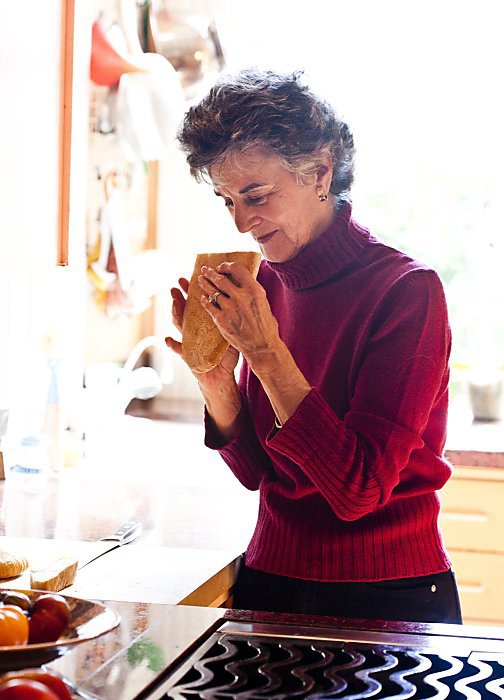By MARK FANTINO
My introduction to Carol Field came in the spring of 1997, in the weeks preceding the release party for her book In Nonna’s Kitchen. An informal dinner was planned with dishes from the book, which was at least one part investigative journalism into the secrets and traditions of Italian grandmothers.
The dinner was to be held at Vivande Ristorante in Opera Plaza, and all of us cooks were to page through the house copy of In Nonna’s Kitchen and select recipes that spoke to us. I chose Tuscan Chicken Liver Pâté (Crostini di Fegatini), which was a bewitching concoction of soft-cooked onions, capers, anchovies and chicken livers, all moistened with Vin Santo.
I remember testing a batch. My coworker peered into my pot, squinched up his face and declared: “That’s everything I hate all mixed together.” I disagreed. But livers, like anchovies, will forever fall firmly into two dividing camps: those who think it must be an acquired taste and those, like me, who insist it is instead a required taste. It remains one of my favorite ways to prepare chicken livers, though difficult to talk about without causing some kind of reaction.
What I liked best about Carol Field’s books were the captivating stories she tied into traditions. Carol was one of those rare authors able to combine academic food writing with the occasional recipe. Those are the best kinds of cookbooks — ones that arm you with background knowledge and a much clearer picture than measuring ingredients and a succession of instructions.
Her best known work will forever be The Italian Baker, and rightly so. But my personal favorite is Celebrating Italy. In it, she composes an almanac of foods and traditions linked up with feast days sprinkled throughout the Italian calendar year that celebrate bizarre saints little known to the rest of the world.
The strangest she writes about is perhaps the blood orange festival in Ivrea — the locals’ way of celebrating the town’s freedom from tyranny, led by one brave young girl, the Miller’s Daughter. Ivrea, in the 12th century, practiced the cruel medieval “right” of prima noctis, which allowed the local lord to sleep with a bride on her wedding night. The Miller’s Daughter concealed a knife in her robes and decapitated the unjust lord. The city went into wild revolt, overcoming the guards of the castle, and the streets ran red with blood. The festival consists of the townsfolk pelting one another with blood oranges, which are not grown in Piedmont and must be imported from the south, in a re-enactment of the battle the townspeople waged on the soldiers with stones. In the end, the streets run red with blood orange juice. In the three days over which the festival takes place, the oranges are not used for food at all — only as artillery.
Another of Carol’s recipes I have used as a secret weapon, particularly when I am truly stuck for an idea, is her Marinated Sole with Pine Nuts and Raisins (Sfogi in Soar), also from Celebrating Italy, which she ties in with the July 19 Feast of the Redeemer in Venice.
The recipe dates back to the late 1500s, and is a small part of a larger festival celebrating the end of a particular plague from that period. It is simplicity: very lightly cooked fillets of sole covered and marinated in cooked onions, toasted pine nuts, raisins and vinegar, served either cold or at room temperature.
The book paints a picture of Venetians bobbing up and down in their boats in the Adriatic lagoons snacking on this wonderful and refreshing sole dish. I have used it at picnics to great success as well as in the form of canapés. Every time they are a smash hit, and I have Carol to thank for that.
I didn’t know Carol well. I am not sure she knew my name. But when you spend so much time reading what someone has written, and it speaks to you, inspires you and fills you with enthusiasm, you feel you know the person. I found myself waving hello as she turned from her Washington Street home onto Fillmore and telling her how much I loved her chicken liver recipe or her marinated sole. My enthusiasm always caught her off guard, and I sometimes felt like I was embarrassing her, which was never my intention. I just wanted her to know I thought her work was great.
She always replied shyly and graciously, usually with just a soft-spoken “thank you.”
Filed under: Books, Food, Drink & Lodging






